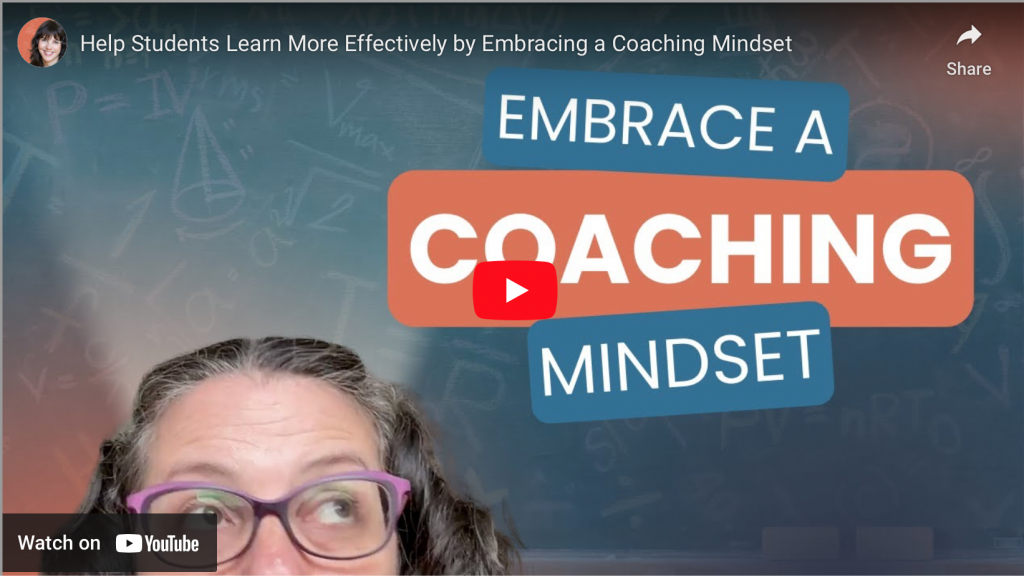Have you ever fallen into the trap of believing that if students just do what “they’re supposed to do,” they will learn (and earn good grades)?
If only learning were that simple…
But let me ask, do your students even know what it is they’re “supposed to do?” Cue the “Coaching Mindset!”
In this week’s video, we’ll uncover why many students don’t already know how to learn, and we’ll also learn a simple, three-step process any coach or teacher can use to scaffold their students’ journey to better learning.
You can click the image below to watch the video… or continue on to read the summary.

In today’s video, I reflect on a conversation I had with an administrator at a medical school where I’ve been consulting. I discuss things I think teachers might need to hear so that they enjoy their teaching more, students enjoy learning more, and learning actually happens.
Often teachers fall into the trap of thinking that if they do what they need to do, students will do what they need to do, and learning will happen.
However, there may be skills students are lacking that will enable them to do the learning they need to do.
For example, we might want students to be able to do a homework assignment. It can be helpful to determine what skills–study skills, time management skills, learning skills–will those students need in order to be able to follow through on that assignment independently. Then we can build a scaffold of those skills to give them the structure and support they need to learn independently.
Scaffolding
One teacher I’ve worked with is very excited to get her students more actively engaged, but she has an extraordinary amount of information she needs to teach. So we spent two hours together figuring out ways she can accomplish both.
- We started by each of us looking at the textbook, with me noticing the structure of the textbook, and her noticing what I was noticing.
- Then we talked about this parenting structure that can be useful scaffolding tool in the classroom, too:
• I Do
• We Do
• You Do
Often teachers will do the “I Do” piece through lecturing and expect that students will do the “You Do” piece of studying. However, the “We Do” piece, which is us doing together whatever I am going to want you to be able to do on your own, gets skipped.
One way to build the “We Do” piece into classroom time is to build in spaced-retrieval (if you don’t know this term, you may want to read more about it and another term, interleaving, to learn how they assist learning) by building lots of small, low stakes or no stakes quizzes into lectures. This can be as simple as stopping a lecture to ask a question that the students answer. An effective method for doing this is to get all of the students to answer at the same time. On Zoom, I like to use the Waterfall Method. For this, the teacher asks a question, everyone types their answer into the chat…BUT everyone waits to hit return and submit their answer until the teacher gives the cue to do so–then, all the answers “waterfall” into the chat at the same time. This is fun, but it also keeps students from getting the answer from someone else who posted to the chat before them, so it truly is a way for each student to see what they know at that moment.
Then, to make the “We Do” piece visible, the teacher points out the fact that the class is doing retrieval practice together, so when students study on their own, it would be helpful for them to build retrieval practice into their study sessions to test themselves.
3. Then we discussed how teachers can teach students to make quizzable study tools to help them with their retrieval practice, including creating a T-Chart. (You can learn more about creating quizzable study tools in my courses, the Anti-Boring Approach to Powerful Studying and the Art of Inspiring Students to Study Strategically!)
The Takeaway
I think there is a difference between a Coaching Mindset and a Teaching Mindset, and coaches can benefit from becoming better teachers, and teachers can benefit from becoming better coaches.
The Coaching Mindset is that coaches have been trained to believe that they are not allowed to teach the student anything, but have to draw the answers out from the student’s natural wisdom.
The Teaching Mindset is that teachers don’t have the time, training, or expertise needed in order to draw out this natural wisdom and must rely solely on teaching.
What’s needed to both coaches and teachers to be more effective is a melding of the two mindsets so everyone, coaches and teachers, incorporate both teaching and coaching techniques into their work with students.
In my Anti-Boring Educators’ Club, we work hard to help coaches identify moments where they can teach and use a process I call the Consent Burger to get student consent before they do so. In my work with teachers at the medical school, I’m helping teachers take more of a coaching approach by prioritizing the We Do in their teaching, and noticing what fundamental scaffolding skills they can practice with their students to enable them to follow-through independently outside of class.
If you’d like to learn more about the Consent Burger and some of my other coaching strategies, you can sign up for my free mini-course Unlock Student Learning!
If you had other takeaways, please post them below! And, if I missed something, let me know that, too! I’d love to hear your thoughts!

